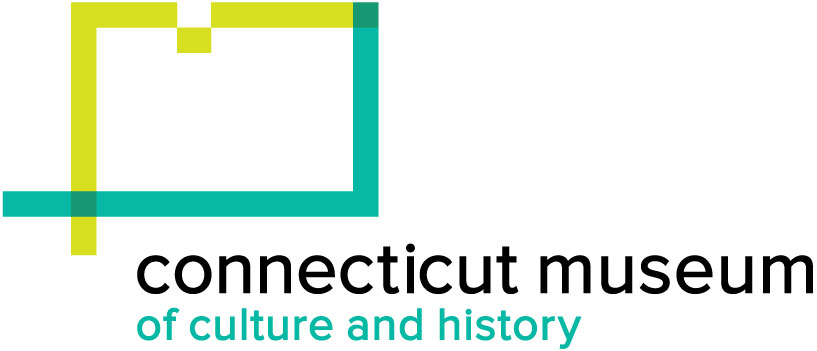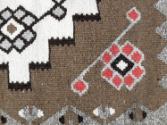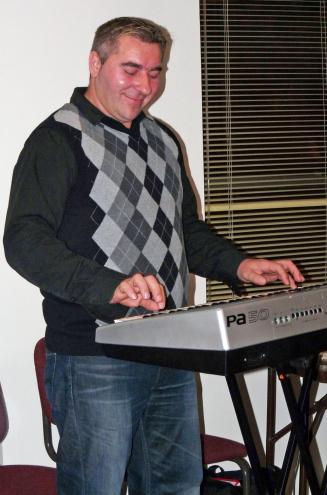Bosnian Weavers at the Hill-Stead Museum May Market, 2011
SubjectPortrait of
Fatima Vejzovic
(Bosnian)
SubjectPortrait of
Ajsa Guster
(Bosnian)
SubjectPortrait of
Katie Apfelbaum
SubjectPortrait of
Anne Foss
Date2011
Mediumborn digital photography
ClassificationsGraphics
Credit LineConnecticut Cultural Heritage Arts Program collections
CopyrightIn Copyright
Object number2015.196.742.1-.18
DescriptionPhotographs of Bosnian weavers who have been part of the Connecticut Cultural Heritage Arts Program's Sewing Circle Project demonstrating and selling their weavings at the 2011 Hill-Stead Museum May Market in Farmington, Connecticut.
(.1) Image of ćilimi (carpets) woven from Connecticut-grown Shetland wool by Hartford Bosnian weavers.
(.2) Image of Bosnian weavers knitting at their display table with crafts for sale. Pictured left to right are Ajsa Guster, Melka, and Fatima Vejzovic.
(.3) Image of Bosnian weavers knitting at their display table with crafts for sale. Pictured left to right are Ajsa Guster, Melka, Trinity College intern Katie Apfelbaum, and Fatima Vejzovic.
(.4) Image of Bosnian weavers Melka and Fatima Vejzovic with Trinity College intern Katie Apfelbaum who holds Fatima's weaving of a goat.
(.5) Image of a weaving made with a goat design created by Fatima Vejzovic.
(.6) Image of Fatima Vejzovic demonstrating weaving.
(.7) Image of Melka with the weavers' display table of Bosnian woven crafts.
(.8) Image of a close-up view of the goat weaving.
(.9) Image of a blue and yellow weaving made by Fatima Vejzovic.
(.10) Image of Fatima Vejzovic showing a catalogue of weavings made in Bosnia to a May Market visitor.
(.11) Image of Fatima Vejzovic talking to Anne Foss and Bobbie Emery, owners of Clatter Ridge Farm who manage the Shetland sheep that produce wool used by the Bosnian weavers.
(.12) Image of Fatima Vejzovic talking to Anne Foss, an owner of Clatter Ridge Farm who manage the Shetland sheep that produce wool used by the Bosnian weavers.
(.13) Image of Shetland sheep from Clatter Ridge Farm, producers of wool used by the Bosnian weavers.
(.14-.18) Images of ćilimi (carpets) woven by Hartford Bosnian weavers using Shetland wool from Clatter Ridge Farm.
NotesSubject Note: The Hill-Stead Museum in Farmington, Connecticut holds an annual May Market public event featuring local craftspeople selling their artworks. Farmers Anne Foss and Bobbie Emery, owners of Clatter Ridge Farm in Farmington, bring their Shetland sheep to the Market for visitors to see, and they sell products made from the wool. The Connecticut Cultural Heritage Arts Program (CCHAP) developed a collaboration with Clatter Ridge Farm to use wool from the Shetland sheep in the carpets made by Hartford Bosnian weavers who participated in the Sewing Circle Project.(.1) Image of ćilimi (carpets) woven from Connecticut-grown Shetland wool by Hartford Bosnian weavers.
(.2) Image of Bosnian weavers knitting at their display table with crafts for sale. Pictured left to right are Ajsa Guster, Melka, and Fatima Vejzovic.
(.3) Image of Bosnian weavers knitting at their display table with crafts for sale. Pictured left to right are Ajsa Guster, Melka, Trinity College intern Katie Apfelbaum, and Fatima Vejzovic.
(.4) Image of Bosnian weavers Melka and Fatima Vejzovic with Trinity College intern Katie Apfelbaum who holds Fatima's weaving of a goat.
(.5) Image of a weaving made with a goat design created by Fatima Vejzovic.
(.6) Image of Fatima Vejzovic demonstrating weaving.
(.7) Image of Melka with the weavers' display table of Bosnian woven crafts.
(.8) Image of a close-up view of the goat weaving.
(.9) Image of a blue and yellow weaving made by Fatima Vejzovic.
(.10) Image of Fatima Vejzovic showing a catalogue of weavings made in Bosnia to a May Market visitor.
(.11) Image of Fatima Vejzovic talking to Anne Foss and Bobbie Emery, owners of Clatter Ridge Farm who manage the Shetland sheep that produce wool used by the Bosnian weavers.
(.12) Image of Fatima Vejzovic talking to Anne Foss, an owner of Clatter Ridge Farm who manage the Shetland sheep that produce wool used by the Bosnian weavers.
(.13) Image of Shetland sheep from Clatter Ridge Farm, producers of wool used by the Bosnian weavers.
(.14-.18) Images of ćilimi (carpets) woven by Hartford Bosnian weavers using Shetland wool from Clatter Ridge Farm.
Subject Note: The Sewing Circle Project began in 2007 as an initiative to encourage production, marketing, and sustainability of traditional crafts among the many immigrant and refugee communities in the Greater Hartford area and across the state. Developed by the Connecticut Cultural Heritage Arts Program (CCHAP) based at the Institute for Community Research (ICR) in Hartford and at the Connecticut Historical Society after 2015, the project supported the remarkable traditional arts of these newcomers. Members of the Sewing Circle met regularly at ICR and the Hartford Public Library to work on their art forms, learn new skills, and share coffee and conversation. This cooperative environment fostered social interaction among the artists and public audiences, respected and encouraged their cultural heritage and artistic traditions, stimulated literacy improvement, and helped to develop marketplaces for their artwork. CCHAP organized gatherings, exhibits, workshops, marketplace events, promotional materials, and educational activities for the group’s participants. While most of the artists experienced war, trauma, and dislocation, they continue to practice their cultural heritage and artistic traditions, blending these with current experiences and materials to create artwork that is both beautiful and functional. Even when immigrants and refugees embrace a move that takes them to a more stable and prosperous place, resettlement poses challenges of physical and psychological adaptation. Many new Americans have eased transition by continuing, recreating, or reinventing familiar art forms. For many members of refugee communities now living in New England, practicing their familiar arts of weaving, knitting, basket making, lace making, music, dance, and storytelling helps them to cope with the trauma of the genocide and displacement their families have suffered.
Engaging with public audiences has given project participants a chance to improve their English-speaking skills and broaden their social networks and support systems. The project has been a great success because it brings some additional income to the artists and also because they have become friends and co-workers sharing techniques, styles, and supplies as they create their unusual and exquisite textiles. In collaboration with Catholic Charities Migration and Refugee Services and the Hartford Public Library, the project is expanding to offer small business training to the artists, thanks to grants from the Aurora Foundation, the Avon Hello Tomorrow Fund, the Aetna Foundation, and the Knox Foundation.
Biographical Note: Fatima Vejzovic is a skilled weaver of traditional Bosnian wool flat-weave carpets made on a simple wooden loom constructed by family members in her home. She learned this traditional craft from mothers, aunts, neighbors, and friends in her village, using wool from sheep raised on their farm. After the war Fatima and many weavers worked for Bosfam, a successful crafts cooperative established in Tuzla to assist women with income-generating projects while providing therapeutic and social support. Their work has appeared in catalogues selling the carpets internationally. Fatima arrived in Hartford with her family in 2002. Greater Hartford is now home to over 10,000 Bosnians, most coming as refugees from the war in the former Yugoslavia. For the women in the community, many of them widows, continuing to practice their familiar arts of weaving, knitting, and crochet lace helps them to cope with the trauma of the genocide their families suffered. Fatima’s art works include large floor carpets as well as smaller weavings, and she fashions the woven tapestry fabric into bags, purses, and pillows. Fatima also makes hand-knitted clothes, crochet lace tablecloths, and Bosnian socks worn inside the home. She won a 2021 Connecticut Office of the Arts Fellowship in Folk and Traditional Arts.
Bosnian flat-weave carpets, called ćilimi after their Turkish antecedents (kilims), adorn all parts of the home – floors, walls, chairs and sofas, tables, and beds. The weavings also serve an important function as prayer rugs for these Muslim families. While sometimes made commercially with chemical dyes, the traditional rugs woven by village women still use wool processed by them and colored with natural dyes. Ćilimi designs maintain their Turkish roots but also show European influences stemming from Bosnia’s close connections with Vienna in the early 20th century. Fatima weaves traditional geometric patterns in seemingly endless variations, and she also enjoys adding floral motifs and creating new pictorial designs. Fatima does not use templates or printed patterns – her designs are created as she starts a weaving on the loom, depending on what colors of wool she has available. She developed a new idea for a weaving depicting a whimsical goat, that she made into bags and wall hangings that have become very popular. Fatima also weaves lettering and names into a ćilim, creating a narrative feature that led to a multi-year commission to produce commemorative banners in the organization’s colors for the Aurora Foundation’s retiring board members.
Through a partnership with Clatter Ridge Farm, whose sheep graze on the grounds of the Hill-Stead Museum in Farmington, Connecticut, Fatima has created a series of weavings using their high-quality Shetland wool. The undyed wool gives the rugs a beautiful softness and durability as well as subtle variations of natural color.
Fatima taught her daughter, Fikreta Muratovic, to weave and they worked together for the Bosfam enterprise in Bosnia. As part of the Southern New England Traditional Arts Apprenticeship Program in 2005, Fatima taught loom weaving to a younger Bosnian woman in Hartford, helping to pass on this beloved tradition in their new home. Fatima has given weaving workshops to Hartford students at four schools through Hartford Performs, and to students from Miss Porters School and the Greater Hartford Academy of the Arts. Fatima has worked with three interns from Trinity College through the Sewing Circle Project. As part of the Hartford Performs program for teaching artists in schools, Fatima has taught the basics of loom weaving to students in Hartford, Windsor Locks, and Miss Porter’s School.
Fatima was one of the founding members of the Sewing Circle Project, which began in early 2007 as a partnership to encourage cultural sustainability among the many immigrant and refugee communities in the Greater Hartford area and across Connecticut. Engaging with public audiences has given Fatima opportunities to improve her English-speaking skills, broaden her social networks, and showcase Bosnian cultural traditions. She has demonstrated and sold her work at the Hartford Public Library World Refugee Day; Hartford Open Studio Weekends; the University of Connecticut; the Hill-Stead Museum; the Vermont Folklife Center; the American Folklore Society; the New York Folklore Society; the West Hartford Art League; Ten Thousand Villages; several local house parties; and at the Billings Forge Farmers Market. She enjoys creating new designs for private commissions. Fatima’s work has been included in exhibitions at the Institute for Community Research, the Connecticut Historical Society, the Connecticut Office of the Arts Gallery, and the Clare Gallery.
Biographical Note: Ajsa Guster is a skilled weaver of Bosnian ćilimi, carpets, wall hangings, and seat covers. She also knits and crochets. She has been a participant in CCHAP’s Sewing Circle Project since its beginning in 2007.
Biographical Note: Katie Apfelbaum was a project intern from Trinity College, doing an outplacement with the Sewing Circle Project as part of her Community Psychology course. Katie gained the trust of the women in the group, assisted at events and sales venues, offered advice from her studies, and accompanied the women to the Immigration Open House at Immigration Headquarters on Main St., Hartford. Katie attended Oxford University and has worked at Brooke Charter Schools and Pioneer Institute for Public Policy Research and Education Resource Strategies.
Additional audio, video, and/or photographic materials exist in the archive relating to this artist.
Cataloging Note: This project was made possible in part by the Institute of Museum and Library Services MA-245929-OMS-20.
Status
Not on viewHaris Gusta Guya
2011 November 4
Fatima Vejzovic
2011 November 16































